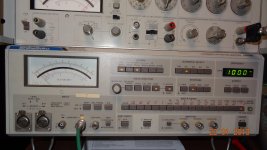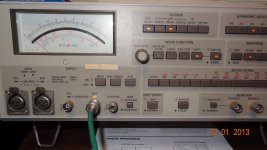This is great but I havent seen any specs for the 10K version yet. Does anyone know what they are and a link to them on ebay or elsewhere?Victor's oscillators measure as specified or better. For a fixed frequency it is by far the best choice. You can't get the parts for the price.
Also do they need an ~ + 35V supply to operate or can a +/- 15V be used?
Larry
They are designed for a floating 35V supply. This gets the ground currents out of the picture. I will be using a battery array but its a little over the top. A simple 35V supply should suffice. I think you could even do something that is not regulated. You could also replace the series 100 Ohm resistor with a current source and have even more supply isolation and flexibility.
They are designed for a floating 35V supply. This gets the ground currents out of the picture. I will be using a battery array but its a little over the top. A simple 35V supply should suffice. I think you could even do something that is not regulated. You could also replace the series 100 Ohm resistor with a current source and have even more supply isolation and flexibility.
I'm using a battery array. It sure is quiet.
I'm using a battery array. It sure is quiet.
What are you doing now to the 339A?... I'm waiting for more parts.... to repair my 339A. RNM
What are you doing now to the 339A?... I'm waiting for more parts.... to repair my 339A. RNM
What went on it?
I haven't done any more on the 339a.
I'm waiting on a PCB for the Twin T and some water slide decal sheets.
Once the Twin T is complete then I can go at it again.
Sure has gotten quiet around here.
Well I'm starting to look for an oscillator? A bit confused.
~~~~~~~~~~
The beginning of knowledge is the discovery of something we do not understand.
~ Frank Herbert
The greatest obstacle to discovery is not ignorance - it is the illusion of knowledge.
~ Daniel J. Boorstin
The real voyage of discovery consists not in seeking new lands but seeing with new eyes.
~ Marcel Proust
~~~~~~~~~~
The beginning of knowledge is the discovery of something we do not understand.
~ Frank Herbert
The greatest obstacle to discovery is not ignorance - it is the illusion of knowledge.
~ Daniel J. Boorstin
The real voyage of discovery consists not in seeking new lands but seeing with new eyes.
~ Marcel Proust
Well I must confess by the deep level of technical info in 157 pages worth of reply to date? Plus the redirections?
The first few pages were fantastic discovery.
May I then ask you to perhaps help answer this question:
Which latest version of a specific product would you recommend to a neophyte like me? For instance a kit including PCB and perhaps parts to achieve this Low-distortion Audio-range Oscillator objective?
My apologies, for not being more specific at this moment? Since I'm somewhat confused?

~~~~~~~~~~
When the student is ready the teacher will appear.
~ Buddhist Proverb
Never discourage anyone...who continually makes progress, no matter how slow.
~ Plato
Great ability develops and reveals itself increasingly with every new assignment.
~ Baltasar Gracian
The first few pages were fantastic discovery.
May I then ask you to perhaps help answer this question:
Which latest version of a specific product would you recommend to a neophyte like me? For instance a kit including PCB and perhaps parts to achieve this Low-distortion Audio-range Oscillator objective?
My apologies, for not being more specific at this moment? Since I'm somewhat confused?
~~~~~~~~~~
When the student is ready the teacher will appear.
~ Buddhist Proverb
Never discourage anyone...who continually makes progress, no matter how slow.
~ Plato
Great ability develops and reveals itself increasingly with every new assignment.
~ Baltasar Gracian
You'll get some replies here -- How low is low for you? The EMU-0204 USB sound modules have pretty decent DAC boards that generate low-distortion output from software like ARTA. Or the QuantAsylum QA400 may be just the ticket.
These days, computer control is pretty good, and performance, while not state of the art, will be good enough for most tasks.
These days, computer control is pretty good, and performance, while not state of the art, will be good enough for most tasks.
I still think Victor's oscillators are the best deal. Contact him here: viccc at ml dot lv. Anything else will be a lot of work and probably not as good.
A QA400 will do a fine job of analyzing and is a real value for the price. However its limited to 1V in and not much more out. I'm working on an interface to make it more useful but got sidetracked by real work.
A QA400 will do a fine job of analyzing and is a real value for the price. However its limited to 1V in and not much more out. I'm working on an interface to make it more useful but got sidetracked by real work.
Last edited by a moderator:
It isnt as bad as it looks --
It really isnt as bad as it looks -- just change the IC's and a few caps and trimmers and you are done with the mods. Then just use its' own analyzer to tune the thd with the trimmers for a null. That's about it. The nice thing about the 339A is that it has a wide range of frequencies and it can be used as an rms voltmeter with db scales. The analyzer will accept a wide range of voltages on its input. It will give you a fast indication of the thd+n with a minimum of fuss and cost less than any other options.
We here got carried away with the oscillator and have been curious as to how low can we make it can go... far lower than the THD meter/analyzer part... but an indication well under .001 (-100dB) should show that you have a pretty good amp/preamp circuit.
The other options mentioned are also fine and may be of acedemic interest for you. They are not hard to use but require more knowledge in use and interpretation/meaning of the results, especially FFT -Thx RNMarsh
[BTW -- the 339A oscillator I have now has 2nd and 3rd at the residual of the ShibaSoku THD analyzer (-135).]
Well I must confess by the deep level of technical info in 157 pages worth of reply to date? Plus the redirections?
The first few pages were fantastic discovery.
May I then ask you to perhaps help answer this question:
Which latest version of a specific product would you recommend to a neophyte like me? For instance a kit including PCB and perhaps parts to achieve this Low-distortion Audio-range Oscillator objective?
My apologies, for not being more specific at this moment? Since I'm somewhat confused?

It really isnt as bad as it looks -- just change the IC's and a few caps and trimmers and you are done with the mods. Then just use its' own analyzer to tune the thd with the trimmers for a null. That's about it. The nice thing about the 339A is that it has a wide range of frequencies and it can be used as an rms voltmeter with db scales. The analyzer will accept a wide range of voltages on its input. It will give you a fast indication of the thd+n with a minimum of fuss and cost less than any other options.
We here got carried away with the oscillator and have been curious as to how low can we make it can go... far lower than the THD meter/analyzer part... but an indication well under .001 (-100dB) should show that you have a pretty good amp/preamp circuit.
The other options mentioned are also fine and may be of acedemic interest for you. They are not hard to use but require more knowledge in use and interpretation/meaning of the results, especially FFT -Thx RNMarsh
[BTW -- the 339A oscillator I have now has 2nd and 3rd at the residual of the ShibaSoku THD analyzer (-135).]
Last edited:
- Home
- Design & Build
- Equipment & Tools
- Low-distortion Audio-range Oscillator

